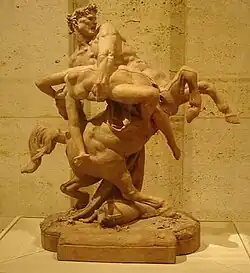The Abduction of Hippodameia
The Abduction of Hippodamia, (French: L'Enlèvement d'Hippodamie) is a work by the 19th-century French sculptor Albert-Ernest Carrier-Belleuse, modeled c. 1877 and cast thereafter.[1]

The subject is from Greek mythology: During the wedding of Hippodamia and Pirithous, the barbaric centaurs who had been invited became wildly intoxicated, attacking the other guests and even the hosts. The centaur Eurytus attempted to carry off the bride, and a battle between the humans and the centaurs ensued.[2]
An earlier similar work, cast in silver, was commissioned by the Jockey Club to be a trophy at the Bois de Boulogne horse races in 1874. Because the trophy was contracted to be unique, the work was remodeled with slight changes to the positioning of Hippodamia and the forcefulness of the centaur.[2]
The sculpture's theme of struggle between the rational and the bestial, expressed in a mythological setting, was a popular one and not unusual in 19th-century European art.[1] Its execution sets it apart, however, and it is by some considered one of the finest examples of its kind in the late 19th century.[2]
It is frequently supposed that Rodin, who was associated with Carrier-Belleuse's studio in the 1870s, contributed to the modeling; the general opinion is that, while the subject matter and the lines of Hippodamia exemplify Carrier-Belleuse's style, the expression and musculature of the centaur suggest Rodin.[1][3][lower-alpha 1]
Notes
- However, according to some sources, Rodin may not have been working with Carrier-Belleuse at the time that The Abduction was designed and reworked.[4]
References
- "The Abduction of Hippodamia". NGA Sculpture Galleries. National Gallery of Art. Retrieved 13 September 2013.
- "Abduction of Hippodamie (L'Enlevement)". Sculpture & Decorative Arts. Hood Museum of Art. Retrieved 13 September 2013.
- Lampert, Catherine, ed. (1986). Rodin: Sculpture & Drawings. Yale University Press. p. 6. ISBN 978-0-30003-832-3.
- Draper, James David (1981). European Terra Cottas from the Arthur M. Sackler Collections. Metropolitan Museum of Art, New York. p. 28. ISBN 0-87099-265-1.